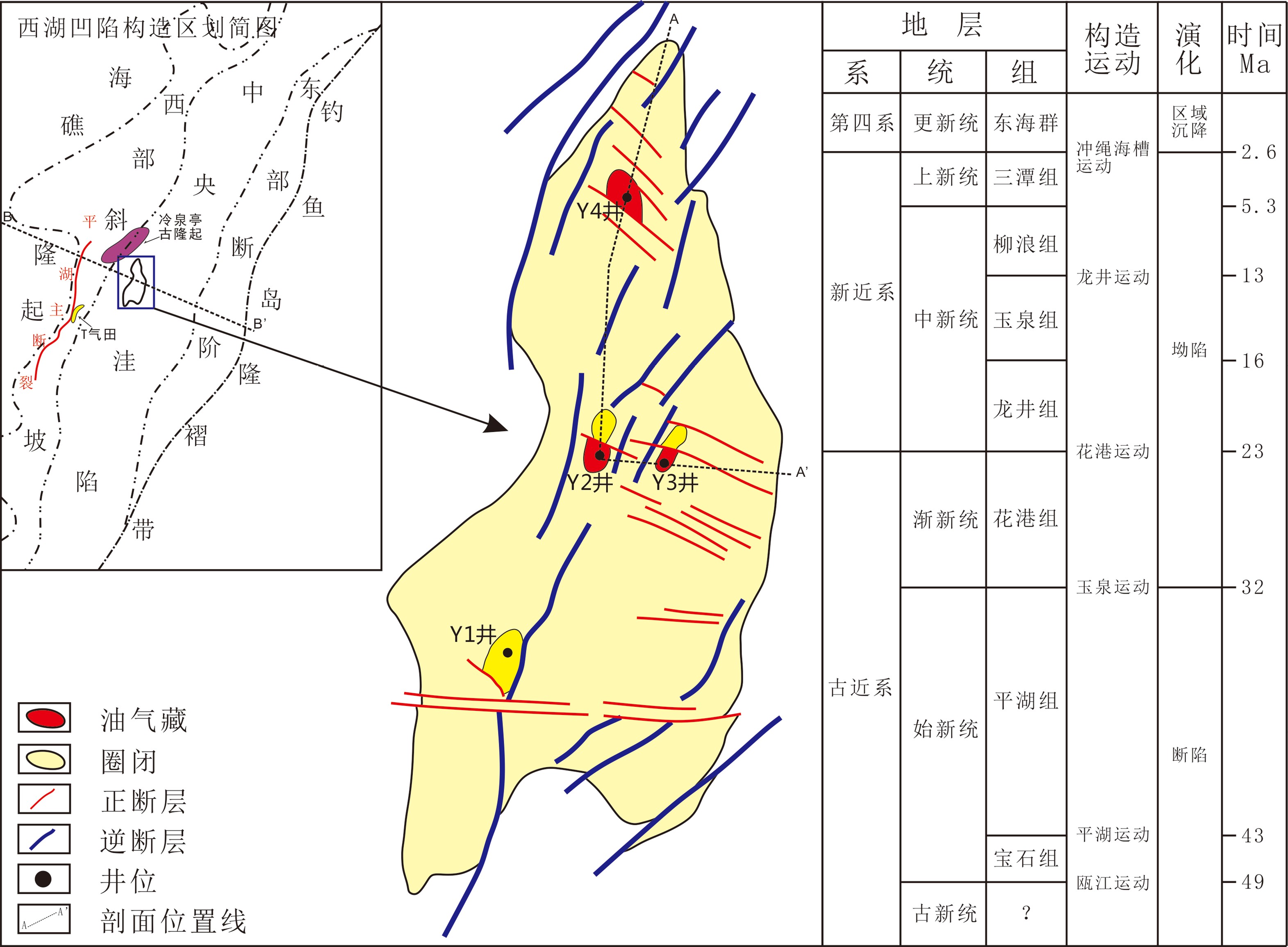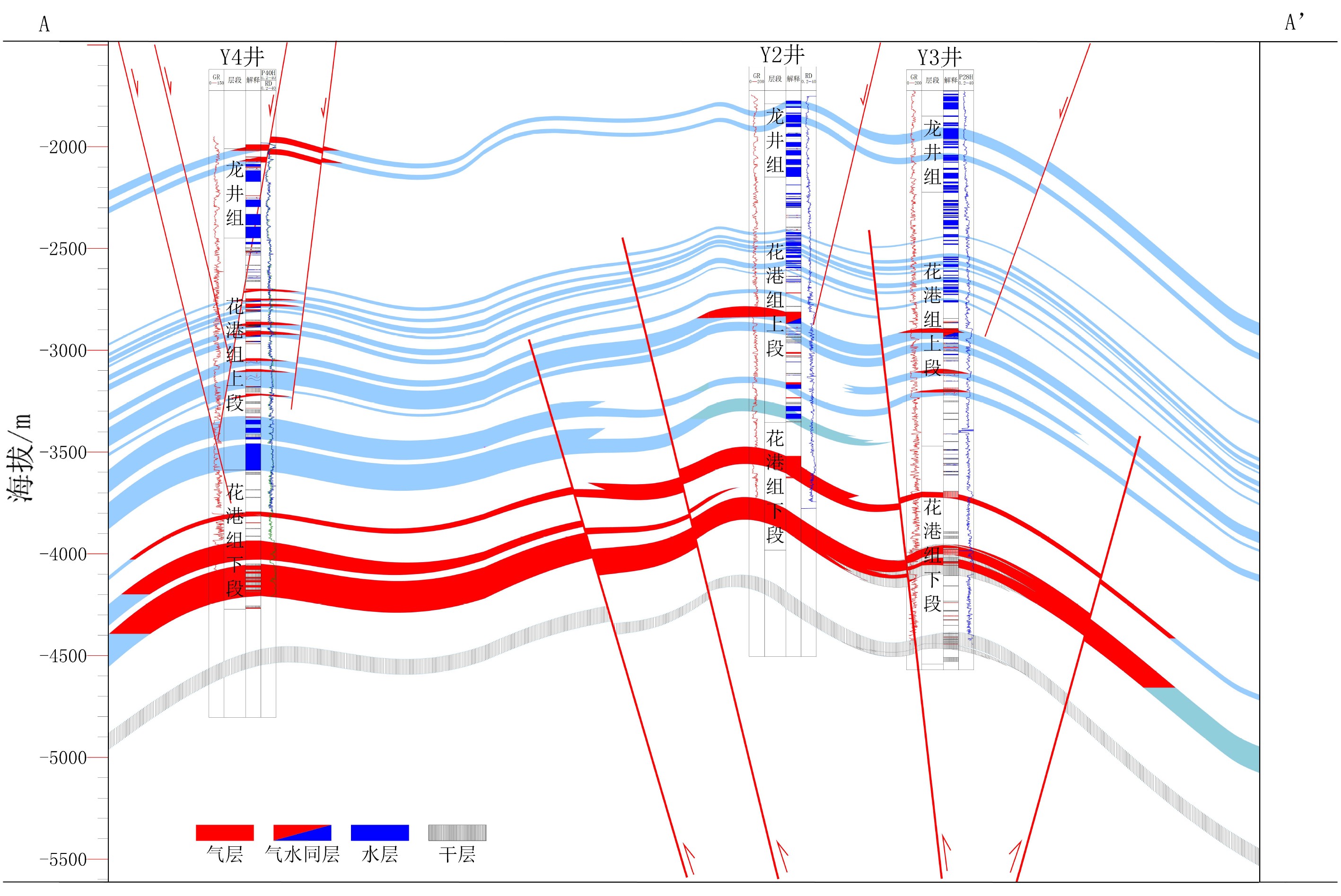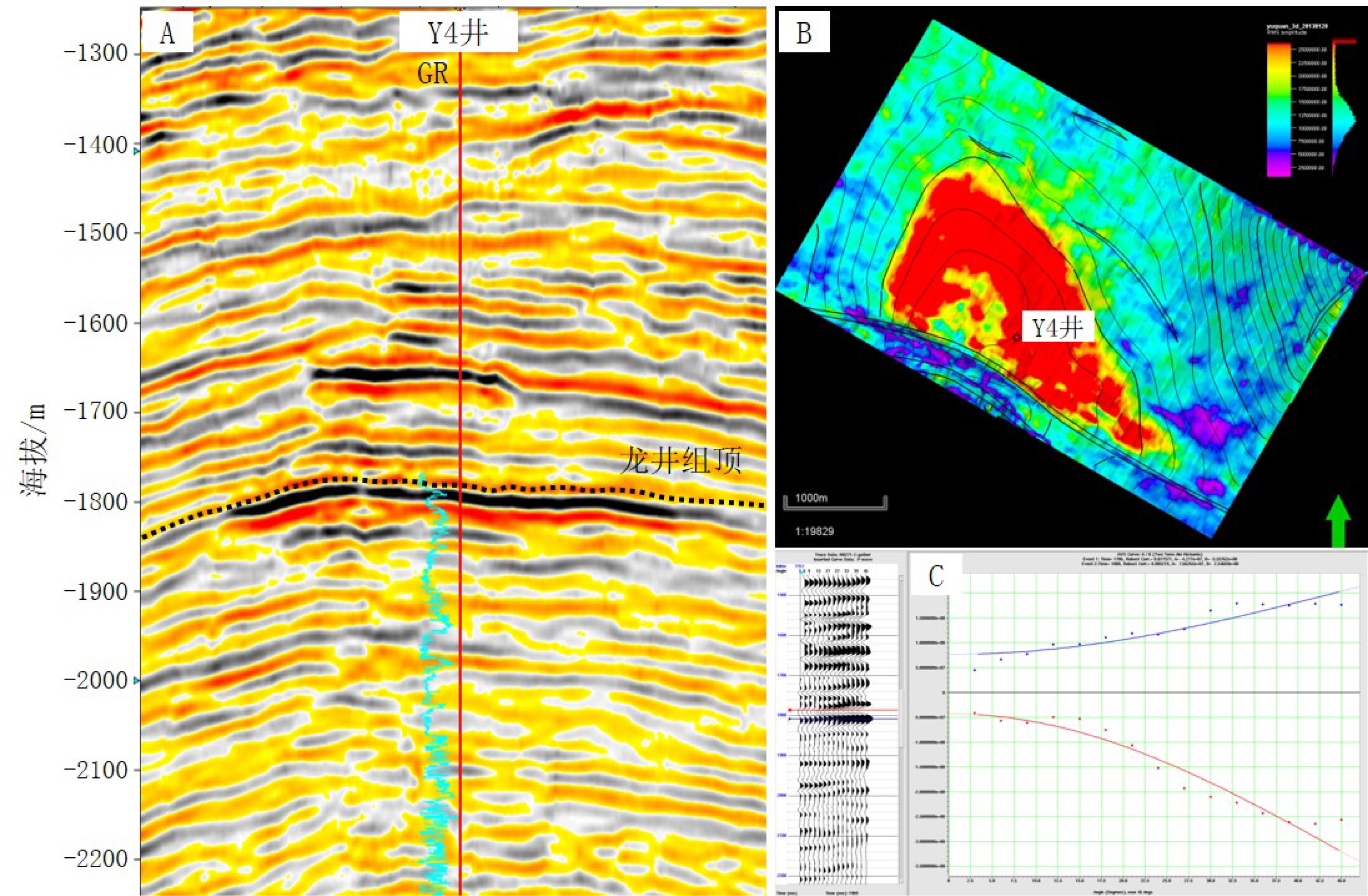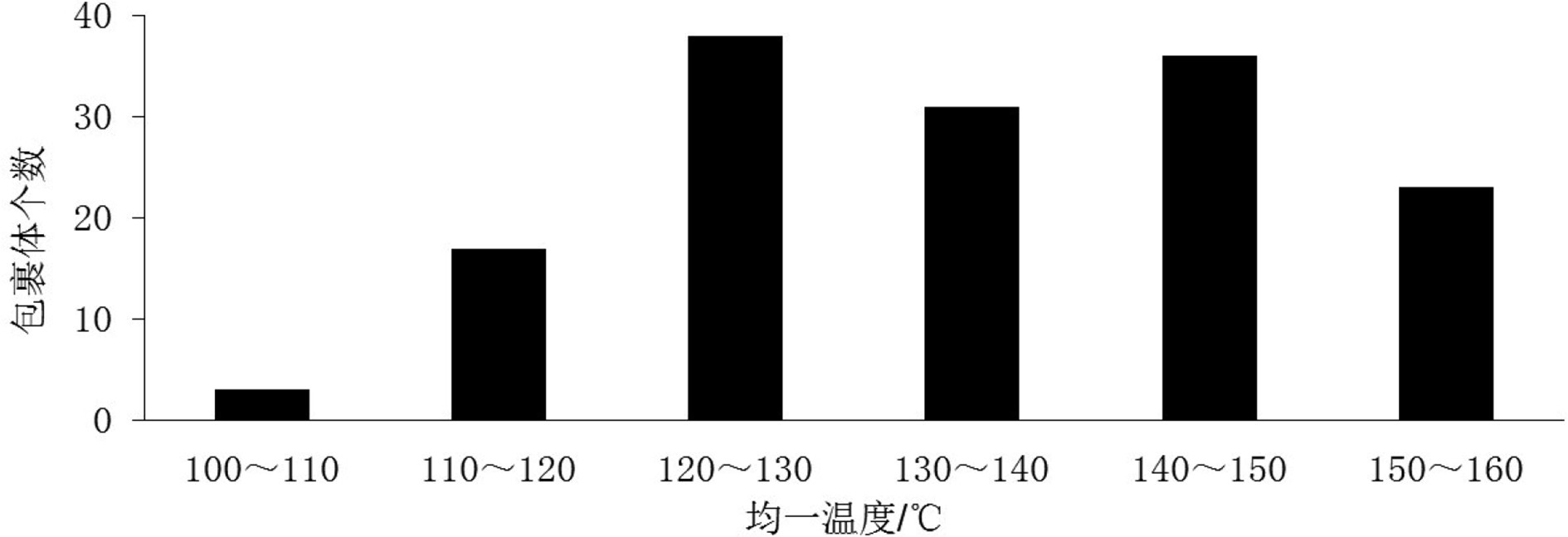Hydrocarbon accumulation process in the Structure Y of Xihu Sag, East China Sea Shelf Basin and its implications for feature exploration
-
摘要: 为了给Y构造下一步评价决策提供成藏支撑,打破勘探瓶颈,本文利用已钻井油气分布特征,综合平衡剖面、多指标油气源综合对比、流体包裹体、盆地模拟等技术研究了Y构造成藏过程。结果表明:Y构造23 Ma—现今共经历3期成藏,最终导致花港组下段聚集规模最大,中间的花港组上段为“过路成藏”,而龙井组以上油气藏小而散;“北强南弱”的挤压机制控制了油气“北富南贫”的总体格局;龙井运动形成的横张断层是控制花港组上段及以上油气纵向分布格局的关键;第一个成藏期内构造中北部花港组下段发育古油藏的局部构造是寻找甜点的有利方向。Abstract: In order to support the next cycle of hydrocarbon resource evaluation and decision making process for the structure Y in the East China Sea Shelf Basin so as to break the bottleneck of future exploration, the hydrocarbon accumulation process of the structure Y was studied by means of balanced sections, multi-index comprehensive correlation of oil and gas sources, fluid inclusions and basin simulation. Results show that the structure has suffered three stages of hydrocarbon accumulation since 23 Ma, which eventually leads to the largest accumulation of hydrocarbon in the lower part of the Huagang Formation. The upper part of the Middle Huagang Formation only has hydrocarbon accumulated while it passes by the structure, and the reservoirs above the Longjing Formation are small and occasionally filled by oil and gas. The compression framework, which is " strong in north and weak in south”, controls the overall distribution pattern which is " rich in north and poor in south”; the transverse tensional fault formed by the Longjing movement is the key to control the vertical distribution pattern of oil and gas in the sequence of the upper Huagang Formation and above. Paleo-reservoirs in the lower part of Huagang Formation formed during the first reservoir forming period are the favorable direction for finding new sweet spots.
-
天然气水合物是由水和气体(最常见气体组分为甲烷)组成的复合物,通常稳定存在于低温、高压,水深大于300 m的近海和湖底沉积层中或永久冻土带内[1]。天然气水合物可能成为未来的洁净能源,与全球能源战略密切相关,同时也涉及地质灾害与海洋工程安全等现实应用问题以及全球气候、环境变化等重大科学问题[2]。近年来,针对天然气水合物的研究成为海洋领域的热点之一[3]。
针对海域天然气水合物的研究呈现明显的多学科交叉特征,主要内容涉及其形成和分解机制、碳循环过程、分布规律、勘探与开发等[4]。就勘探与分布预测而言,海域天然气水合物的分布区大多都是通过地震反射剖面上的似海底反射(BSR)特征来推断的,这也意味着地震勘探是当前天然气水合物识别的主要手段。基于BSR之上含水合物沉积物与BSR之下可能含游离气沉积物之间存在明显阻抗差异的特征[5],形成一系列天然气水合物地震识别及其分布预测方法,包括地震属性分析[6-12]、地震速度分析[13-15]、无井约束稀疏脉冲反演[16-19]和井-震联合稀疏脉冲反演[20]、走时反演(层析成像)[21]、全波形反演[4, 22-25]、叠前反演[26]和地震谱反演[14, 27-29]等。另外,根据AVO响应的特征差异,AVO正演分析在水合物的厚度和饱和度预测中也有成功应用[30-36]。由于水合物储层具有较强的非均质性、规模小且横向上变化快的特点,利用常规的地震反演方法难以精确地刻画其水合物分布状态,且国际上对非均质性水合物储层预测技术的研究较少。如果含水合物沉积层下伏存在游离气,其响应频率会发生明显衰减,衰减程度主要受孔隙发育程度和气体含量等的影响,因而频率可作为水合物储层识别的一个重要属性,国内外学者已将时频分析应用到薄储层油气预测的研究,且取得了较好的效果[37]。
回顾时频分析的发展历程,Widess[38]首先提出用时频量化来描述薄储层的技术方法,主要建立在精细处理、正确的子波相位和真正的道间距振幅之间的关系上,后来,Morlet等[39]把时频分析技术应用到了石油勘探中,Partyka等[40]借助先进的计算机技术把时频分析技术转化为一种实用、便捷的地震解释工具,即地震谱分解技术(Spectral Decomposition),此后谱分解技术在储层描述中被广泛应用。Ren等[41]根据Biot饱和流体孔隙介质地震波的传播理论,设计了不同岩性和物性参数模型在低、中、高频地震响应的变化规律与机理,并将AVF(不同时间厚度下振幅和频率的关系)引入时频分析中逐渐发展为分频反演,它的反演结果可以更加精细地刻画实际地层之间的接触关系,具有更高的分辨率、与井的吻合率较高的算法,是地震反演技术新的发展方向。
中国南海神狐海域的天然气水合物具有独特的成藏特征,其含水合物沉积层主要以厚、薄不一的互层形式存在且横向分布不均,通常以强复合反射BSR为其底界面标志,给水合物资源量精确评价带来困难[42-44],尤其是与流体运移通道相关的厚块状水合物在地震剖面上很难直接识别并预测其厚度[29]。本文尝试利用相位转换和时频分析等手段提高地震纵向分辨率,采用基于向量机(SVM)的分频反演方法,将反演结果与区域地质特点结合,分析含天然气水合物沉积层的空间分布特点并探讨其形成模式。
1. 地震分频原理
1.1 分频反演
分频反演方法是一种全新的全频约束反演方法,比常规反演具有更高的分辨率。该方法主要是依靠测井曲线数据和地震数据,通过研究不同地层厚度下的振幅与频率之间的响应关系(AVF),将AVF作为独立信息引入反演,合理利用地震的低频,中频和高频带信息,减少薄层反演的不确定性,得到一个高分辨率的反演结果[45-54]。
设地震记录
$s(t) \in {L^2}(R)$ ,${L^2}(R)$ 表示能量有限函数空间,$g(t)$ 为基本小波,$s(t)$ 相对于$g(t)$ 的小波变换定义为:$$S(b,a) = \frac{1}{a}\int_{ - \infty }^\infty {s(t)\overline {g\left(\frac{{t - b}}{a}\right)} } {\rm d}t$$ (1) 式中,
$a$ 为非零实数(称为尺度因子),$b$ 为实数(称为平移因子),$\overline {g(t)} $ 表示对$g(t)$ 取复共轭。对(1)式进一步求得
$s(t)$ 分频处理的结果$S_i^*(b)$ ,其离散形式为:$$ {S}_{i}^{*}(b)={\omega }^{*}(b){\displaystyle \sum _{j=1}^{M}\frac{{Z}_{j+1}-{Z}_{j}}{{Z}_{j+1}+{Z}_{j}}}{\rm{\delta}} ({{b-}}{T}_{\rm{j}})$$ (2) 式中,
${\omega ^*}(b)$ 为小波分频的新子波,${Z_j}$ 为阻抗,$ {\rm{\delta}} ({{b-}}{T}_{\rm{j}})$ 为狄拉克函数,通过分解(2)式,最终可以得到:$$ {Z}_{i,k}={Z}_{i,k-1}+u({A}_{\rm{k-1}}^{T}{A}_{k-1}+{\rm{\varepsilon}} I{)}^{-1}{A}_{k-1}^{T}({S}_{\rm{i}}^{*}-{S}_{k-1})$$ (3) 式中,
$i$ 为反演的区间范围$ ({{a}}_{i-1},{a}_{i})$ ,$k$ 为迭代次数,$S_i^*$ 为$ ({{a}}_{i-1},{a}_{i})$ 区间范围内的地震数据,${S_{k - 1}}$ 为(2)式计算的地震记录,${\rm{\varepsilon}} $ 为正则化因子,$u$ 为控制迭代速度的加速收敛因子。设计一个楔状模型(图1a),通过不同主频的子波与其反射系数进行褶积,得到一系列的合成地震记录剖面,从而得到振幅与厚度在不同频率时的调谐曲线(图1b)。地震波形是阻抗(AI)和时间厚度(H)的函数,反演时仅根据振幅同时求解AI和H,即已知一个参数求解两个未知数,结果是多解的。AVF揭示了一个重要规律:同一地层在不同的主频子波下会展现不同的振幅特征,而AVF关系非常复杂,很难用一个显示函数表示,因此通过支持向量机(SVM)非线性映射的方法,在测井和地震子波分解剖面上找到这种对应关系,利用AVF的响应关系进行反演。
1.2 支持向量机原理
SVM由Vapnik于1992年首次提出,它是一种类似神经网络的计算方法,可以作为模式分类和非线性回归,通过3个参数控制的学习方法,克服了神经网络所存在的比如局部最优,过度学习和网络不稳定等问题,为统计学习和人工智能中非常先进的算法。其基本思想是对于一个给定的具有优先数量训练样本,通过适当地选择函数子集及其该子集中的函数判别,使得学习机器的实际风险达到最小,得到最佳的推广泛化能力[53]。
假设
$N$ 个两类≥线性可分样本的特征为${x_n} \in {R^d}$ ($d$ 为特征维数),其类别标签为:$$ {y}_{n}\in \{+1,-1\},\;{{n}}=1,2, \cdots N $$ (4) 将样本线性分离的超平面可以改成:
$$ y{}_n = \left\{ {\begin{array}{*{20}{c}} { + 1\begin{array}{*{20}{l}} {}&{x_n^{\rm T}w + b {\text{≥}} + 1} \end{array}}\\ { - 1\begin{array}{*{20}{l}} {}&{x_n^{\rm T}w + b {\text{≤}} - 1} \end{array}} \end{array}} \right. $$ (5) 以上两个式子合并为:
$$ {y_n}\left( {x_n^{\rm T}w + b} \right) - 1 {\text{≥}} 0 $$ (6) 其中:
$ x_n^Tw + b = 0$ 分类间距为:
$2/\left\| w \right\|$ ,为了使得间隔最大,实际上是使:$$ \Phi (w)=\frac{1}{2}{\Vert w\Vert }^{2}=\frac{1}{2}{w}^{\rm T}w=\frac{1}{2}({w}^{0}w)$$ (7) 求解最优分类面就是求取(7)式在(6)式约束条件下的极值,而超过平面
${H_1}$ 和${H_2}$ 的样本点就是极值点,此时支持了超平面,称之为支持向量。在特征空间F内,为了满足在(6)式条件下求的极小值:$$ {\rm{min}}J(w,\xi )=\frac{1}{2}{w}^{0}w+{\displaystyle \sum _{i=1}^{n}{\xi }_{i}}$$ (8) 利用Lagrange优化方法可求解上述问题,将支持向量机的优化问题转化为求解二次归化问题:
$$\left\{ {\begin{array}{*{20}{l}} {\max W\left( {\rm{a}} \right) = \displaystyle\sum\limits_{i = 1}^n {{a_i}} {\rm{ - }}\frac{1}{2}\displaystyle\sum\limits_{i = 1}^n {\displaystyle\sum\limits_{j = 1}^n {{a_i}} } {a_j}{y_i}{y_j}K\left( {{x_i}{x_j}} \right)}\\ {s \cdot \displaystyle\sum\limits_{i = 1}^n {{a_i}{y_i} = 0\begin{array}{*{20}{c}} {}&{0 {\text{≤}} {a_i} {\text{≤}} c,\begin{array}{*{20}{c}} {}&{i = 1,2, \cdots {{n}}} \end{array}} \end{array}} } \end{array}} \right.$$ (9) 式中,
$ K({x}_{i}{x}_{j})$ 为任何一个满足Mercer条件的核函数,较常用的核函数有线性核:$$ K(x,z)={x}^{\rm T}z$$ (10) 多项式核:
$$ K(x,z)={({x}^{\rm T}z+1)}^{d}$$ (11) 高斯核:
$$ K(x,z)={\rm{exp}}\left[-\frac{{\Vert x-z\Vert }^{2}}{2{{\rm{\sigma}} }^{2}}\right]$$ (12) 1.3 分频反演步骤
(1)对地震数据进行频谱分析,获得目标层段地震频带范围和噪声分布;
(2)在水合物有效目标层位内选择有对水合物敏感的弹性参数曲线,将有代表的测井曲线和地质参数作为样本;
(3)对地震数据进行中值滤波,去掉地震异常、平滑地震记录,有效地保护边缘信号以及对尖锐噪声进行有效平滑的特点;
(4)根据对地震数据的频宽、低—中—高频和主频特点,设计分频间隔点,采用小波分频原理对地震数据进行分频,并对分频数据进行地震属性提取,从而产生不同频段的地震属性数据;
(5)建立目标测井曲线和分频地震属性的非线性映射关系(AVF),利用支持向量机(SVM)方法建立分频属性和目标曲线之间的非线性关系,通过训练学习,直到反演结果与实际井曲线特征相对应。
2. 区域地质背景
神狐海域位于珠江口盆地的白云凹陷内部(图2),处于欧亚、太平洋和印度—澳大利亚三大板块交汇处附近的华南大陆南缘,其形成和发展与南海盆地的构造运动密切相关,历经了神狐、珠琼、南海和东沙运动等5次大的构造运动[55-56]。自渐新世晚期以来,南海北部的陆坡处于拗陷期,沉积环境为滨浅海—半深海,物源供给充足,沉积速率大且地层厚、岩石粒度为中—上等偏细。中新世晚期以后,该区以三角洲和扇三角洲沉积为主,滑塌扇、浊积扇和重力流非常发育。到第四纪时期,发育滑塌扇,以上沉积体具有较快的沉积速率,沉积厚度大,有机质比较丰富,上覆块体快速堆积使得有机质能够得到有效保存。由于多次地壳运动和多阶构造演化,发育了NE、NW和NNE向正断层,断裂的发育和新构造运动还诱发了深部超压泥质岩类的塑性流动,形成泥底辟活动带,泥底辟与其上覆较陡的断裂以及垂向裂隙系统共同构成了流体的渗漏通道,为天然气向上运移到浅部水合物稳定带运移创造了有利条件[57-60]。
3. 含天然气水合物沉积层地球物理响应特征
3.1 BSR地震反射特征
水合物稳定带受温压条件限制,其底界面通常以强振幅的BSR为特征。在研究海域,BSR位于海底之下135~230 mbsf,其强振幅反射特征明显,波形极性与海底相反并与正常沉积地层斜交,横向延伸长度为1.7~5.36 km[62](图3)。在钻获天然气水合物位置处,BSR由一系列强反射界面联合组成,这是由于沉积物孔隙和渗透等差异导致天然气水合物饱和度不同,在垂向上形成物性差异所致。BSR上方振幅空白带显示明显,下部的杂乱或模糊反射与游离气的存在有关。
3.2 测井响应分析
2015年,广州海洋地质调查局在研究区W03站位(水深1 295.41 m)进行随钻测井和取样。结果表明,此处含天然气水合物沉积层厚度近80 m,是迄今在南海所有发现含水合物沉积中最厚的。图4是W03井位置的电阻率、纵波速度、密度与自然伽马测井曲线。根据电阻率和纵波速度曲线,海底之下沉积层具有典型的“三段区间”变化特征。第1段区间为1 295.41~1 424.14 m,沉积层电阻率基本保持不变,约1.57 Ω·m,表明沉积物物性稳定,而纵波速度曲线呈线性缓慢增长趋势,说明与沉积压实作用有关。密度与自然伽马曲线都表现为小幅度振荡,密度为1.76~1.89 g/cm3,自然伽马的平均值大约为65 API。密度与自然伽马测井曲线的振荡特征可能与沉积层中粉砂质/泥的比值变化以及孔隙水含量的变化有关。第2段区间为1 424.14~1 504.24 m,从1 424.14 m的深度段往下,电阻率以1.57 Ω·m和纵波速度以1 770 m/s开始迅速增大,其最大值分别达到8 Ω·m和2 315 m/s,1 424~1 504 m深度段(厚度约80 m)的高电阻率、高声波速度异常指示着天然气水合物的存在。取样分析结果表明,这一深度区间内水合物层厚最薄为4 m,最厚为34 m,平均含水合物饱和度为24.4%,平均渗透率为2.58 mD,渗透性较差。另外,这一深度区间的密度测井曲线没有明显减小,说明水合物不是以大块状或厚层状存在,而是以弥散状分布于沉积层中。自然伽马曲线在这一深度区间表现出升高—降低—再升高的变化特征。通常天然气水合物赋存区段的孔隙度相对较高,也就是砂/泥比会上升,对应的自然伽马会相对下降,而此处自然伽马值整体较高的原因是放射性较高的有孔虫化石,为天然气水合物的生长和聚集提供了空间。
3.3 非均质性储层特征
南海北部陆坡神狐海域水合物储层是以厚薄相间的水合物存在,相关学者[42]在2015年水合物钻探的19口井中,通过常规测井和随钻成像测井(GVR)发现,厚层水合物以厚层状和分散状分布,薄层水合物以斑块状和薄层状分布。厚层状水合物发现存在于W02、W07、W11和W16井,其中厚层状水合物埋藏较深,主要分布在100~200 mbsf,且厚度较大,单层厚度可达10 m,主要分布在厚层水合物层的顶部,电阻率频谱较窄,为明显单峰,主要为高饱和水合物。另一种厚层水合物以分散状分布,主要发现在W01、W02、W07、W11、W17和W19井中,GVR图像为分散状浸染分布于基质中,厚度也较大,单层厚度可达5 m以上,主要分布在厚层状水合物之下、厚层水合物层的中部,电阻率为频谱较宽的单峰,水合物为中饱和度。薄层状水合物以斑块状分布于基质中,主要发现在W02和W19井中,斑块状水合物非均质性强,大的斑块状水合物可达0.4 m,小的斑块状水合物只有0.1 m,其分布规律不明显,主要分布于分散状水合物的下面、且厚层水合物层的底部,具有较强的非均质性,为高饱和—中饱和水合物。薄层状水合物在每口井中存在,通过测井曲线(中子、密度和声波速度)都无法识别,只有GVR图像上显示高亮和电阻率呈增大特征[42]。
厚薄相间水合物的存在形式,使得水合物地层的物理性质改变,具有各向非均质性,大大增加了天然气水合物储层识别的困难,本文主要采用分频反演方法解决以上问题。主要以厚薄的楔状模型为例,分别采用约束稀疏脉冲反演方法和分频反演方法,通过对比论证分频反演方法在厚薄相间天然气水合物储层中的适用性。
4. 非均质性天然气水合物识别技术
4.1 基于正演模型的反演方法对比
目前天然气水合物储层预测主要通过约束稀疏脉冲反演方法,理论技术上可以有效预测厚度范围在λ/4~2λ/3,去掉模型精度对反演结果的影响,该技术实际也只能应用于λ/4~λ/2之间的厚度,如果想要识别更厚或更薄的物体,仍需要测井信息的加入,这就降低了其预测性[63]。为了验证分频反演对厚薄储层识别的有效性,通过设计的widess楔形模型(图5a),选用主频为30 Hz的子波进行正演模拟(图5b),分别采用稀疏脉冲反演和分频反演方法,可以看出稀疏脉冲反演的识别范围为λ/4~2λ/3(图5c),该方法是主要是利用地震资料主频信息,但如果要识别物体的厚度范围,需要加入准确的初始低频模型,而天然气水合物勘探中钻井数量少,要得到精确的初始低频模型十分困难。分频反演的预测结果能识别出厚度范围为λ/8~λ的储层(图5d),尤其适合对超过常规分辨率的厚层水合物进行刻画,相对稀疏脉冲反演方法具有明显优势[46, 64],预测的厚度更加接近于设计的楔形模型,该方法更适合用于天然气水合物厚度变化范围较大的储层预测。
![]() 图 5 楔状模型正演下不同反演方法储层厚度识别对比a. Widess楔状模型,b. 30 Hz地震正演模拟,c. 稀疏脉冲反演结果,d. 谱反演结果。Figure 5. Identification and comparison of reservoir thickness by different inversion methods under Widess wedge modela. Widess wedge model, b. 30 Hz seismic forward simulation, c. sparse pulse inversion results, d. frequency-divided inversion results.
图 5 楔状模型正演下不同反演方法储层厚度识别对比a. Widess楔状模型,b. 30 Hz地震正演模拟,c. 稀疏脉冲反演结果,d. 谱反演结果。Figure 5. Identification and comparison of reservoir thickness by different inversion methods under Widess wedge modela. Widess wedge model, b. 30 Hz seismic forward simulation, c. sparse pulse inversion results, d. frequency-divided inversion results.4.2 目标曲线确定
将水合物层段和非水合物层段的声波阻抗和电阻率进行交汇(图6),红色部分为含水合物样品,绿色为非水合物样品,水合物沉积层与非水合物沉积层还存在重叠的声波阻抗区间,假如直接利用井中波阻抗曲线作为目标属性进行相关反演,很难取得较好的效果。由图可以看出根据声阻抗的门槛值(橘红色)区分的水合物和非水合物区域效果不如深电阻率(蓝色,门槛值为2.6 Ω·m)的效果好,且电阻率比速度曲线更能刻画水合物的顶底及其物性特征,因此在反演过程中,通过以电阻率曲线作为学习目标,充分利用地震资料中有效频带中的相对高频和相对低频信息,又保持了总体趋势,利用电阻率曲线的分频反演能够更加有效地刻画水合物的具体形态和范围。
4.3 地震分频频段
将水合物层段的地震进行频谱扫描,其频率主要分布在6~160 Hz,主频为60 Hz(图7),具有明显的富低频和宽频的特征,为充分利用各个频率段的信息,按照频宽范围,将频带设置为6、15、30、45、60、90、120、150 Hz等几个频段分隔点。
4.4 支持向量机的分频反演
通过对地震数据进行频谱分解,将分解的频谱能量体对各频段数据体计算振幅、频率和相位等地震属性。利用电阻率曲线和低频模型,对分频的属性数据利用SVM方法进行训练,计算不同厚度下AVF的关系,将AVF关系引入分频反演,建立电阻率曲线与地震波形之间的非线性映射关系(图8)。最终将每个分频属性体作为输入,利用训练好的分频体和反演体之间的AVF关系,合成最终的反演体[48, 50, 53, 65]。
5. 反演结果及分析
5.1 分频反演结果可靠性评价
地震主频60 Hz的地震数据,其纵向分辨率为8 m,对于小于8 m的薄层其地震分辨率比较难以识别。下面通过对比原始地震剖面与过井的深电阻率曲线(图9a),发现在测井曲线异常段地震存在较强的阻抗界面,由图从上往下可以看出,图中红色箭头所指显示第一个强反射地震反射轴与深电阻率对应的结果很好,第二个地震反射轴为双峰的强反射,而测井上电阻率显示含水合物层较薄,第三个地震反射轴为频率较高的薄层反射特征,而深电阻率曲线显示的含水合物层较厚。通过对原始地震进行90°相位转换,重新进行井震标定(图9b),从上往下可以看出,第一个强反射轴与深电阻率曲线与之前一样,比较吻合;第二强反射轴由双峰变成单峰,强轴对应水合物的顶界,但是无法区分该套水合物的厚度;第三个强反射轴地震频率形态振幅还是不变,与深电阻率曲线还是不能够吻合。通过以上技术手段发现,对于薄层的地震反射特点利用90°相位转换可以只能显示水合物的顶界,但是不能区分薄层的厚度;对于厚层的含水合物层,利用90°相位转换方法既不能区分水合物的顶底界面,也不能区分厚度。
本文利用分频反演方法对南海神狐海域天然气水合物进行反演(图10),可以看出,反演结果与已钻遇井相当吻合,通过充分利用井点的低频和高频,以及地震的中频部分,有效地对分频反演结果的有效频带进行合理拓宽,能够分辨出5 m的水合物薄层,且水合物薄层的尖灭点比较清晰。因此,通过分频反演结果能够较好地反映研究区天然气水合物矿体的展布形态。
5.2 分析与讨论
研究区水合物分布为厚层状和薄层状,厚层状水合物是研究区主力水合物层,一般埋藏较深,主要分布在海床下100~200 m,厚度也较厚,单层厚度甚至可达10~80 m,厚层状的水合物主要为高饱和水合物,其次为中饱和水合物,可组成多期旋回。根据分频反演结果(图10),水合物在空间上具有多层分布,不论在垂向上还是在平面都具有分布不均匀的特征。厚层状水合物在横向上分布也较为稳定,一般需要下部具有充足的气灶。薄层状水合物在神狐海域的每口井都均有分布,分布较为广泛,海床下几十米到几百米均有分布,薄层状水合物分布较为分散,埋藏较浅,也有可能为厚层水合物的分支。根据反演结果,可以看出位于该井处分布着3套水合物和天然气组合层。根据成像测井揭示和地震资料解释结果,位于水合物沉积层顶部发育为一条NE向的高角度界面型断层,该断层作为岩性界面对水合物起着遮挡作用,并沟通了上下几套水合物层,且有利于水合物的保存。
影响天然气水合物空间分布不均匀,厚薄相间的原因除了具有水深和温压条件,还受到气源、沉积环境和构造因素的影响[66-67]。
从始新世开始,深部有机质热解成气,在流体势的作用下沿着NE、NW和NWW向断层向上运移,在低温高压条件下,热解气和流体结合形成水合物,气压充足,水合物为厚层状,为“流体运移通道型”水合物藏,含有水合物地层的沉积速率一般都超过30 m/Ma[68]。沉积环境是由于各种快速沉积和厚度大的浊积扇、斜坡扇及三角洲等沉积体系前缘、滑塌块体和等渗流沉积,是水合物富集的有利沉积相带,沉积物中的流体由于滑塌作用而受侧向压实导致其他地方大量扩散,进而形成水合物[69]。有利于天然气水合物运移的构造条件为气烟囱和断层,气烟囱与BSR的平面分布范围有良好的空间匹配关系,剖面上表现为“下拉”的地震反射特征,由于地震波能量被吸收造成地震反射模糊或空白的效果,相对周围地层具有直立的通道形态,顶部常会发生横向扩张表现为花状或蘑菇状,气烟囱并没有延伸至海底,而是在BSR下部终止。深部的热解成因气沿着切穿沉积盖层的断裂形成上升的气流体,顺着这些断层为深部气源向浅部运移提供了通道[70],断层与BSR的发育具有良好的匹配关系(图11)。这种类型的水合物矿藏深部气源供给充足,稳定带厚度大,饱和度及丰度高,且展布规模及资源潜力巨大。其中深部气源供给、气烟囱和断裂等输导形成下生上储“流体运移通道型”天然气水合物矿藏的主控因素[71-72]。
晚中新世及上新世开始,位于深水海底浅层(100~230 mbsf)的未成岩沉积物中,来自原地浅层沉积物中有机质生物化学作用形成的生物甲烷烃气源,尚伴有少量深部热解气,构成了以生物气为主的混合气气源,通过扩散运聚作用方式形成“原地自生自储扩散型”的天然气水合物成藏模式。这种类型的水合物矿藏埋藏浅,水合物稳定带厚度薄,一般不超过200 m,水合物饱和度及丰度不太高,气源潜力及资源规模较小。其中浅层生物气及渗透性良好的储层是形成“原地自生自储扩散型”天然气水合物矿藏的主控因素[73]。
6. 结论
(1)由支持向量机分频反演结果和井点的电阻率测井曲线的吻合度,说明该反演方法在本区对天然气水合物刻画的适用性。结果表明,天然气水合物空间上具有分布不均匀的特征,厚层横向上分布较为稳定,埋藏较深;薄层较为分散,埋藏较浅,可能为厚层水合物的分支。
(2)影响该区天然气水合物分布不均匀原因除了水深和温压条件外,主要受到气源、沉积环境和构造条件影响。晚中新世开始,构造运动频繁,将深部热解气沿着气烟囱和断层等纵向通道向上运移,形成厚层状“流体运移渗漏型”天然气水合物藏。海底沉积物中微生物作用成烃的生物气,通过渗透性良好的储层形成“原地自生自储扩散型”天然气水合物藏。
-
图 2 Y构造气藏剖面图(剖面位置见图1)
Figure 2. A profile of the oil and gas accumulation in Structure Y
图 3 Y构造浅部层系待证实油气藏地球物理响应特征
A.常规地震剖面,B.均方根振幅属性与构造等值线叠合图,C.叠前道集AVO特征曲线
Figure 3. Geophysical response characteristics of oil and gas reservoirs to be confirmed in the structure Y
A. conventional seismic profiles, B. overlapping maps of RMS amplitude attributes and tectonic isolines, C. AVO characteristic curves of prestack gathers
图 5 过Y构造并横跨西湖凹陷平衡地质剖面(剖面位置见图1)
Figure 5. Balanced section across Structure Y and the Xihu Sag
表 1 Y构造综合油源对比
Table 1 Comprehensive oil source correlation for structure Y
井号 层位 样品类型 二萜含量 γ蜡烷指数 Ts/Tm C27-C28-C29分布型式 Pr/Ph Y4井 花港组 泥岩 低 0.34 1.22 “L”型 0.16 Y4井 花港组 油 高 0.45 0.55 反“L”型 4.7 Y4井 花港组 油 高 0.48 0.61 反“L”型 5.2 T气田 平湖组 油 高 0 0.37 反“L”型 5.5 T气田 平湖组 泥岩 高 0.17~0.38 0.33~0.43 反“L”型 3.02~6.29 -
[1] 杨丽娜, 陈琳琳, 汤健, 等. 东海西湖凹陷玉泉构造成藏分析[J]. 海洋石油, 2013, 33(2):54-58. [YANG Lina, CHEN Linlin, TANG Jian, et al. Analysis of HC accumulation in Yuquan structure of Xihu Depression at East China Sea [J]. Offshore Oil, 2013, 33(2): 54-58. doi: 10.3969/j.issn.1008-2336.2013.02.054 [2] 苏奥, 陈红汉, 王存武, 等. 东海盆地西湖凹陷油气成因及成熟度判别[J]. 石油勘探与开发, 2013, 40(5):521-527. [SU Ao, CHEN Honghan, WANG Cunwu, et al. Genesis and maturity identification of oil and gas in the Xihu Sag, East China Sea Basin [J]. Petroleum Exploration and Development, 2013, 40(5): 521-527. doi: 10.11698/PED.2013.05.02 [3] 刘建, 张文慧, 高翠欣, 等. 准南霍玛吐背斜带天然气成因类型及来源[J]. 海洋地质与第四纪地质, 2016, 36(3):135-141. [LIU Jian, ZHANG Wenhui, GAO Cuixin, et al. Genetic type and source of the natural gas in HUO-MA-TUO articline zone in the southern Junggar Basin [J]. Marine Geology & Quaternary Geology, 2016, 36(3): 135-141. [4] 刘文汇, 徐永昌. 煤型气碳同位素演化二阶段分馏模式及机理[J]. 地球化学, 1997, 28(4):359-366. [LIU Wenhui, XU Yongchang. A two-stage model of carbon isotopic fractionation in coal-gas [J]. Geochimica, 1997, 28(4): 359-366. [5] 李宁, 覃军, 江瀚, 等. 西湖凹陷T气田油气分布特征与主控因素[J]. 断块油气田, 2017, 24(3):329-332. [LI Ning, QIN Jun, JIANG Han, et al. Hydrocarbon distribution features and its main controlling factors of T gas field, Xihu Sag, East China Sea Shelf Basin [J]. Fault-block Oil & Gas Field, 2017, 24(3): 329-332. [6] 李居云, 姜波, 屈争辉, 等. 东海西湖凹陷构造演化及控煤作用[J]. 煤田地质与勘探, 2016, 44(5):22-27. [LI Juyun, JIANG Bo, QU Zhenghui, et al. Tectonic evolution and control of coal in Donghai Xihu Sag [J]. Coal Geology & Exploration, 2016, 44(5): 22-27. doi: 10.3969/j.issn.1001-1986.2016.05.004 [7] 张远兴, 叶加仁, 苏克露, 等. 东海西湖凹陷沉降史与构造演化[J]. 大地构造与成矿学, 2009, 33(2):215-223. [ZHANG Yuanxing, YE Jiaren, SU Kelu, et al. The burial history and evolution of Xihu Depression [J]. Geotectonica et Metallogenia, 2009, 33(2): 215-223. doi: 10.3969/j.issn.1001-1552.2009.02.004 [8] 郭真, 刘池洋, 田建锋. 东海盆地西湖凹陷反转构造特征及其形成的动力环境[J]. 地学前缘, 2015, 22(3):59-67. [GUO Zhen, LIU Chiyang, TIAN Jianfeng. Structural characteristics and main controlling factors of inversion structures in Donghai Xihu Depression [J]. Earth Science Frontiers, 2015, 22(3): 59-67. [9] 胡梦颖, 李三忠, 戴黎明, 等. 西湖凹陷中北部反转构造动力学机制的数值模拟[J]. 海洋地质与第四纪地质, 2017, 37(4):151-166. [HU Mengying, LI Sanzhong, DAI Liming, et al. Numerical dynamic modeling of tectonic inversion in the northeastern Xihu Sag [J]. Marine Geology & Quaternary Geology, 2017, 37(4): 151-166. [10] 何将启. 东海西湖凹陷构造-热历史分析[D]. 同济大学博士学位论文, 2004. HE Jiangqi. Tectono-thermal history of Xihu Depression, East China Sea[D]. Doctor Dissertation of Tongji University, 2004.
[11] 蔡华, 张建培, 唐贤君. 西湖凹陷断裂系统特征及其控藏机制[J]. 天然气工业, 2014, 34(10):18-26. [CAI Hua, ZHANG Jianpei, TANG Xianjun. Characteristics of the fault systems and their control on hydrocarbon accumulation in the Xihu Sag, East China Sea Shelf Basin [J]. Natural Gas Industry, 2014, 34(10): 18-26. doi: 10.3787/j.issn.1000-0976.2014.10.003 [12] 谢月芳, 陈敏娟, 王坚勇. 东海西湖凹陷浙东中央背斜带中南部油气成藏规律与晚期剪切断层的关系探讨[J]. 海洋石油, 2002(2):8-13. [XIE Yuefang, CHEN Minjuan, WANG Jianyong. Pattern of oil and gas accumulation in the south and middle part of Zhedong Central Anticline area [J]. Offshore Oil, 2002(2): 8-13. doi: 10.3969/j.issn.1008-2336.2002.02.002 [13] 熊斌辉, 王春红, 张锦伟, 等. 西湖凹陷龙井运动特征[J]. 中国海上油气, 2008, 20(2):77-81. [XIONG Binhui, WANG Chunhong, ZHANG Jinwei, et al. Longjing movement characteristics in Xihu Sag [J]. China Offshore Oil and Gas, 2008, 20(2): 77-81. doi: 10.3969/j.issn.1673-1506.2008.02.002 [14] 刘可禹, 鲁雪松, 桂丽黎, 等. 储层定量荧光技术及其在油气成藏研究中的应用[J]. 地球科学, 2016, 41(3):373-384. [LIU Keyu, LU Xuesong, GUI Lili, et al. Quantitative fluorescence techniques and their applications in hydrocarbon accumulation studies [J]. Earth Science, 2016, 41(3): 373-384. [15] 刘金水, 唐健程. 西湖凹陷低渗储层微观孔隙结构与渗流特征及其地质意义--以HY构造花港组为例[J]. 中国海上油气, 2013, 25(2):18-23. [LIU Jinshui, TANG Jiancheng. Mircoscopic pore texture and percolation features in the low permeability reservoirs and their geological significance in Xihu Sag: A case of Huagang Formation in HY structure [J]. China Offshore Oil and Gas, 2013, 25(2): 18-23. [16] 张武, 徐发, 徐国盛, 等. 西湖凹陷某构造花港组致密砂岩储层成岩作用与孔隙演化[J]. 成都理工大学学报: 自然科学版, 2012, 39(2):122-129. [ZHANG Wu, XU Fa, XU Guosheng, et al. Diagenesis and pore evolution of Huagang Formation tight sandstone reservoirs in a structure of Xihu Depression in East China Sea Basin [J]. Journal of Chengdu University of Technology: Science & Technology Edition, 2012, 39(2): 122-129. [17] 孙相灿, 杨传胜, 于兴河, 等. 冀中坳陷深县凹陷古近系碎屑岩储层成岩作用及成岩演化序列分析[J]. 海洋地质与第四纪地质, 2014, 34(2):135-142. [SUN Xiangcan, YANG Chuansheng, YU Xinghe, et al. Diagenesis and diagenetic sequence of Paleogene sandstone reservoir in Shenxian Depression, Jizhong Sub-Basin [J]. Marine Geology & Quaternary Geology, 2014, 34(2): 135-142. [18] 纪友亮, 高崇龙, 刘玉瑞, 等. 高邮凹陷阜一段油气充注对储层物性演化的影响[J]. 同济大学学报: 自然科学版, 2015, 43(1):133-139. [JI Youliang, GAO Chonglong, LIU Yurui, et al. Influence of hydrocarbon charging to the reservoir property in 1st member of funning formation in Gaoyou Depression [J]. Journal of Tongji University: Natural Science, 2015, 43(1): 133-139. [19] 宋世骏, 柳益群, 郑庆华, 等. 含凝灰质致密油层成岩作用与原油充注特点: 以鄂尔多斯盆地西北部长4+5段为例[J]. 地质科技情报, 2018, 37(5):54-62. [SONG Shijun, LIU Yiqun, ZHENG Qinghua, et al. Diagenesis and oil filling characteristics of tuffaceous tight reservoir: a case study of Chang 4+5 member in Northwest of Ordos Basin [J]. Geological Science and Technology Information, 2018, 37(5): 54-62. [20] 孟元林, 潘雪梅, 吴河勇, 等. 松辽盆地北部中浅层含油饱和度和孔隙度的关系与油气侵位对成岩作用的抑制[J]. 矿物岩石地球化学通报, 2010, 29(1):11-16. [MENG Yuanlin, PAN Xuemei, WU Heyong, et al. Porosity and oil saturation correlation and diagenetic retardation of sandstone by hydrocarbon emplacement in the Shallow-Middle strata of the Northern Songliao Basin [J]. Bulletin of Mineralogy, Petrology and Geochemistry, 2010, 29(1): 11-16. doi: 10.3969/j.issn.1007-2802.2010.01.002 [21] 张守鹏, 李博. 渤海湾盆地东营凹陷示烃成岩作用及其演化特征[J]. 古地理学报, 2018, 20(6):1043-1052. [ZHANG Shoupeng, LI Bo. Diagenesis and evolution characteristics of hydrocarbon-traced minerals in Dongying Sag, Bohai Bay basin [J]. Journal of Palaeogeography, 2018, 20(6): 1043-1052. doi: 10.7605/gdlxb.2018.06.077 [22] 夏青松, 黄成刚, 陆江. 沉积盆地中油气充注与储集层成岩作用的响应关系[J]. 地球科学与环境学报, 2019, 41(2):185-196. [XIA Qingsong, HUANG Chenggang, LU Jiang. Response relationship between hydrocarbon charging and diagenesis of reservoirs in sedimentary basin [J]. Journal of Earth Sciences and Environment, 2019, 41(2): 185-196. doi: 10.3969/j.issn.1672-6561.2019.02.005 -
期刊类型引用(5)
1. 李灿苹,鲍炳煌,常亮,张海荣,陈凤英,王睿,黄淯辉. 基于随机介质理论模拟水合物和游离气储层. 海洋地质与第四纪地质. 2025(01): 199-209 .  本站查看
本站查看
2. 靳继凯,温欣,张艺博,赵春晖. 基于机器学习的深海能源土降压开采沉降预测. 工业技术与职业教育. 2023(06): 16-19 .  百度学术
百度学术
3. 邓海东,隋波,张亮,程川辉,陈祖银. 方向可控金字塔方法在复杂断块油田微断层识别中的应用. 地球物理学进展. 2022(02): 817-823 .  百度学术
百度学术
4. 尉佳,冯京,杨睿,孙军,王威. 海洋地震垂直缆在自由状态下的照明情况. 海洋地质前沿. 2022(05): 33-40 .  百度学术
百度学术
5. 李鹏举,田甜,魏双宝. 天然气水合物饱和度碳氧比测井的解释模型. 黑龙江科技大学学报. 2021(03): 289-294 .  百度学术
百度学术
其他类型引用(2)





























 下载:
下载:






































